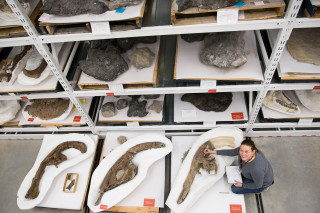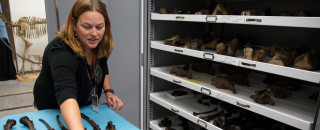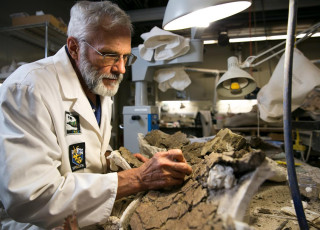Behind the Scenes, a Fossil Treasure Trove
By Riley Black
Carolyn Levitt-Bussian has a fossil lover’s dream job. Every day that she comes to work at the Natural History Museum of Utah, she gets to roam among the dinosaurs. That’s because she’s the collections manager for the museum’s world-class fossil repository, protecting and overseeing tens of thousands of fossil specimens spanning over 500 million years of life’s history.
Entering new specimens into databases and rearranging massive, heavy jackets with a forklift may not exactly be what people picture when they think of paleontology, Levitt-Bussian admits. “Many people think of paleontology as digging up the bones in a fossil excavation, like the beginning scene of Jurassic Park, and then they magically end up as mounts in a museum,” she says. But the role of the collections manager resides between the field and the museum itself, organizing and caring for specimens so that analysis and study of those fossils can proceed.
It’s a big job. The number of specimens under Levitt-Bussian’s care, she says, changes every day, especially during the warm months when the museum runs collecting trips. But, speaking roughly, she estimates that the museum holds about 5,500 fossil plant specimens, about 5,700 fossil invertebrates, over 30,000 vertebrate fossils, not including about 30 holotype fossils that are unique specimens used to name new species. They range in size from ammonites you can hold in the palm of your hand to the bones of dinosaurs that stand taller than any person does.
And these fossils don’t just stay put on the shelf. In addition to research carried out by the museum’s paleontology staff and University of Utah students, experts from all over the world either come to visit our fossils or ask to have them loaned to other institutions. It’s a lot to keep track of, requiring Levitt-Bussian keeps a running tab of specimen numbers, field notes, preparation sheets, permits, publications, and more.
Acting as the museum’s very own fossil librarian is the culmination of a long journey for Levitt-Bussian. Following an early interest in paleontology, Levitt-Bussian says, in high school she had the chance to intern at Chicago’s Field Museum with collections manager Bill Simpson. “I loved what the job entailed, how organized he was, and he seemed to be in charge of all the fossils,” she says. “I wanted to be in charge of all the fossils, too.”
Not that tracking old bones and petrified plants is the whole job. Levitt-Bussian notes that her role is evenly split between research, fieldwork, and collections management, requiring a wide array of skills. In addition to getting forklift certified to move huge plaster field jackets around, she says, she also took Wilderness First Responder training “to be the ‘medic’ for the injuries that occur out in the field.’” Fossil or human, she knows how to deal with broken bones.
As the summer field season kicks up, Levitt-Bussian will continue to put those skills to work in the desert as well as the museum. But even as new fossils come in, she admits she has a few longstanding favorites in collections. The skull of Kosmoceratops richardsoni stands out, Levitt-Bussian says, because all the bones are still together in life position. The dinosaur seems to be smiling. And, she adds, a close runner up is an Allosaurus fragilis femur with amethyst inside it, the mineral shining from within the dinosaur bone.
These are not static objects, of course. They don’t just sit and collect dust like crates in an Indiana Jones movie. These fossils are part of Earth’s story, with scientists from all over the world hoping to parse those secrets. Levitt-Bussian’s work helps move that process along. “The most rewarding part of being a collections manager,” she says, “is feeling that every day I am facilitating and adding to science happening right now.”

Riley Black is the author of My Beloved Brontosaurus, Prehistoric Predators, and a science writer for the Natural History Museum of Utah, a part of the University of Utah in Salt Lake City. Our mission is to illuminate the natural world and the place of humans within it. In addition to housing outstanding exhibits for the public, NHMU is a research museum. Learn more.

